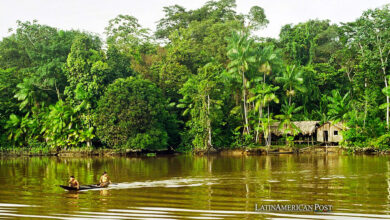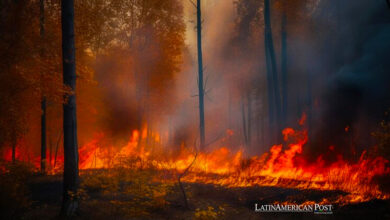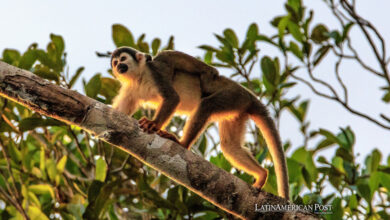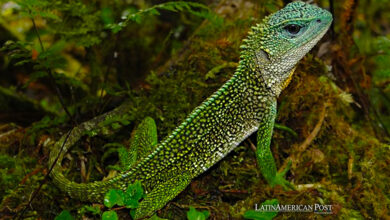Valdivian forest: a biogeographic island that was saved from the glaciations
Although in the collective imagination the South American jungles are tropical climate environments, a narrow Patagonian strip, located between Argentina and Chile, has its own temperate jungle: the Valdivian forest .

The ecoregion is located between Argentina and Chile. / Photo: Wikimedia – Albh
LatinamericanPost| Jorge Guasp
Escucha este artículo
Leer en español: Bosque valdiviano: una isla biogeográfica que quedó a salvo de las glaciaciones
Characteristics and location of the Valdivian forest
"The area of greatest structural complexity, richness and number of endemic species is located in the Cordillera de la Costa, between 36º and 41º South latitude, a region that has provided an important refuge for rainforest species in recent glaciation periods ”(Summary Vision for the biodiversity of the ecoregion of the temperate rain forests of Chile and Argentina, World Wide Fund for Nature –WWF-).
In effect, the Andes Mountains protected the Valdivian zone from glaciations during the Pleistocene, and turned it into a biogeographic island. Once the ice was removed, the Cordillera de la Costa served as a seedbed, and its vegetation colonized the adjacent areas. This situation highlights the age of these forests, which extend through some 250,000 km² . That same Andes Mountain Range, which separates Chile from Argentina, is the one that stops the prevailing winds from the Pacific Ocean, and causes rains that reach 4,000 mm annually, or even more, in a climate of low thermal amplitude thanks to the oceanic influence .
The Valdivian environment is part of the Andean Patagonian forest. However, this temperate climate jungle differs from the rest of that ecoregion, shared by Chile and Argentina, by the high rainfall volume , which makes it a humid environment with high biodiversity, with a high percentage of endemism (organisms that they only develop in this environment).
The name of the Valdivian forest comes from the Chilean city of Valdivia, one of the most important in the region. "These forests contain the endemic Pehuén (Araucaria araucana), a tree existing since the time of the dinosaurs, as well as the second oldest living organism on earth: the endemic conifer called Larch (Fitzroya cupressoides), which can live up to 3,600 years and measure up to 5m in diameter and 60m in height ”(Protecting the Valdivian forests of Chile and Argentina, WWF).
The predominant species of the Valdivian jungle are perennial (they do not lose their leaves) . This environment houses plants that are not found in the rest of the Andean Patagonian forest, since they require abundant humidity: tineo, tepa, mañiú, guaitecas cypress, ulmo, hazelnut, cinnamon, laurel, lingue, nalca, palo santo, olivillo and others, along with numerous mosses, ferns, lichens, fungi, and vines.
National Parks where you can visit the Valdivian forest
The Valdivian jungle is part of some protected natural areas, which have tourist infrastructure. In Los Alerces National Park (Chubut, Argentina), a World Heritage Site since 2017, you can visit the Alerzal Milenario, a larch forest that gives its name to the natural area. The excursion consists of navigating Lake Menéndez, followed by a walk through a path of about 2 km in length, which allows access to huge and ancient specimens of larch, in the middle of a Valdivian forest.
In the case of the Nahuel Huapi National Park, which surrounds the city of San Carlos de Bariloche (Argentina), the Valdivian jungle is located in the Puerto Blest area. The lake excursion begins in Puerto Pañuelo, in front of the famous Llao Lao hotel, and consists of sailing to the Cántaros Waterfall and the homonymous lake, where you can see examples of larch. The trip then continues to Puerto Blest, on Lake Nahuel Huapi and in the heart of the Valdivian jungle.
Also read: Avoiding illegal wildlife trafficking can prevent pandemics
The Chiloé National Park is located in the Chiloé archipelago, Chile, about 50 km from Castro, the capital of the large island of Chiloé. The protected area is located on the Pacific coast, and offers trails, viewpoints and beaches, in a Valdivian jungle environment.
For the most daring and reluctant to make traditional excursions, one option is the Quehulat National Park, located in the middle of the Valdivian jungle, south of Chaitén and north of Coyahaique. This is a remote area of Chile, sparsely populated and lush in nature. The natural area is also reached from the Argentine province of Chubut, but access is difficult and an all-wheel drive vehicle is required. The Quehulat National Park has an amazing beauty, and stands out for its hanging snowdrifts (whose thaw generates waterfalls in the middle of the dense jungle), and for the huge leaves of the nalcas that line the route.
The Valdivian jungle, an ancient treasure of incalculable value
This forest of Gondwanic origin (Gondwana formed the southern part of the Pangea supercontinent), which has lasted until today thanks to moderate temperatures, high rainfall and its isolation from Pleistocene glacial ices, is witness to a prehistoric past, still present in a diverse and exuberant nature, which deserves to be known and preserved.





